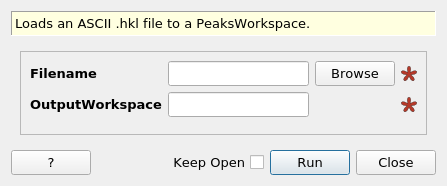\(\renewcommand\AA{\unicode{x212B}}\)
LoadHKL v1¶

LoadHKL dialog.¶
Summary¶
Loads an ASCII .hkl file to a PeaksWorkspace.
See Also¶
Properties¶
Name |
Direction |
Type |
Default |
Description |
|---|---|---|---|---|
Filename |
Input |
string |
Mandatory |
Path to an hkl file to save. Allowed extensions: [‘.hkl’] |
OutputWorkspace |
Output |
PeaksWorkspace |
Mandatory |
Name of the output workspace. |
Description¶
Loads an ASCII .hkl file to a PeaksWorkspace.
HKL File Format¶
File has same format that works successfully in GSAS and SHELX from ISAW:
hklFile.write(‘%4d%4d%4d%8.2f%8.2f%4d%8.4f%7.4f%7d%7d%7.4f%4d%9.5f%9.4f\n’% (H, K, L, FSQ, SIGFSQ, hstnum, WL, TBAR, CURHST, SEQNUM, TRANSMISSION, DN, TWOTH, DSP))
HKL is flipped by -1 due to different q convention in ISAW vs Mantid.
FSQ = integrated intensity of peak (scaled)
SIGFSQ = sigma from integrating peak
hstnum = number of sample orientation (starting at 1)
WL = wavelength of peak
TBAR = output of absorption correction (-log(transmission)/mu)
CURHST = run number of sample
SEQNUM = peak number (unique number for each peak in file)
TRANSMISSION = output of absorption correction (exp(-mu*tbar))
DN = detector bank number
TWOTH = two-theta scattering angle
DSP = d-Spacing of peak (Angstroms)/TR
Last line must have all 0’s
Usage¶
Example
import os
# make a peaks workspace
LoadEmptyInstrument(InstrumentName='SXD', OutputWorkspace='sxd')
ub = np.array([[-0.00601763, 0.07397297, 0.05865706],
[0.05373321, 0.050198, -0.05651455],
[-0.07822144, 0.0295911, -0.04489172]])
SetUB('SXD', UB=ub)
wsPeaks = PredictPeaks('SXD', WavelengthMin=1, WavelengthMax=1.1,
MinDSpacing=1, MaxDSPacing=1.1)
# save and load peaks in .hkl format
SaveHKL(wsPeaks, Filename='testHKL.hkl')
wsHKL = LoadHKL('testHKL.hkl')
#remove the file we created
alg = wsHKL.getHistory().lastAlgorithm()
filePath = alg.getPropertyValue("Filename")
os.remove(filePath)
Categories: AlgorithmIndex | Crystal\DataHandling | DataHandling\Text
Source¶
C++ header: LoadHKL.h
C++ source: LoadHKL.cpp
